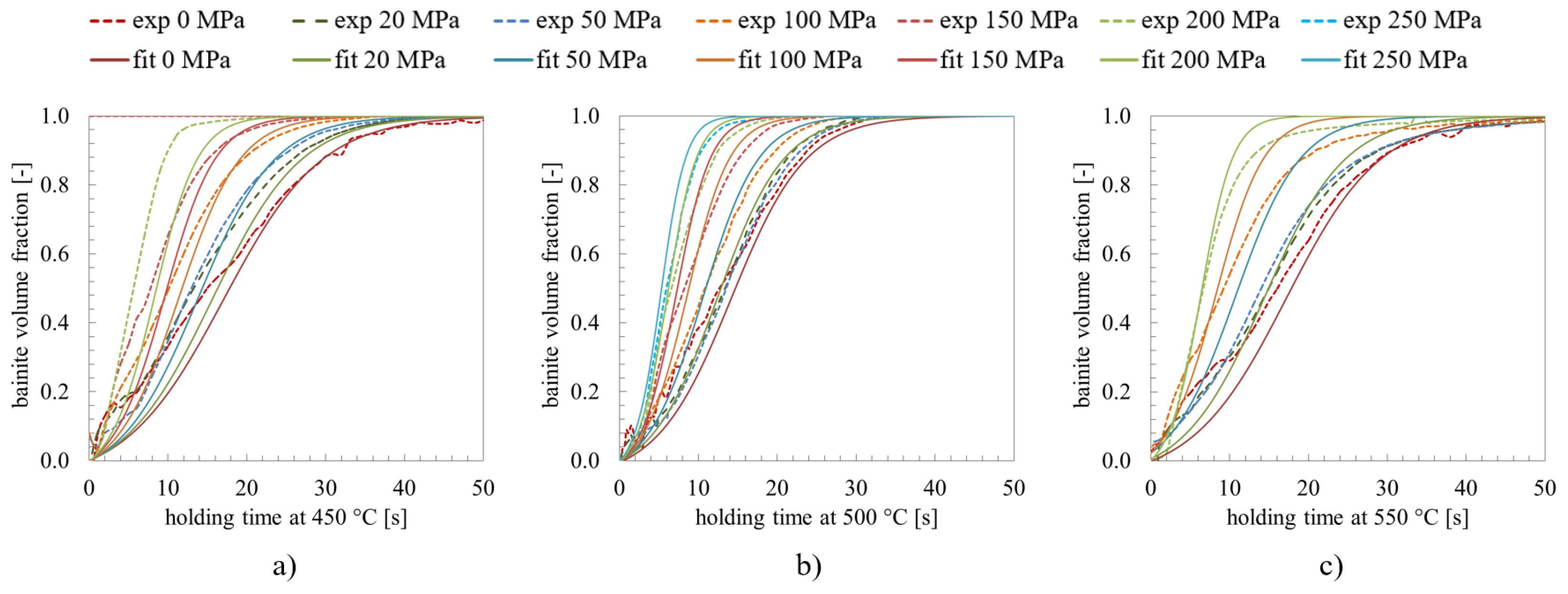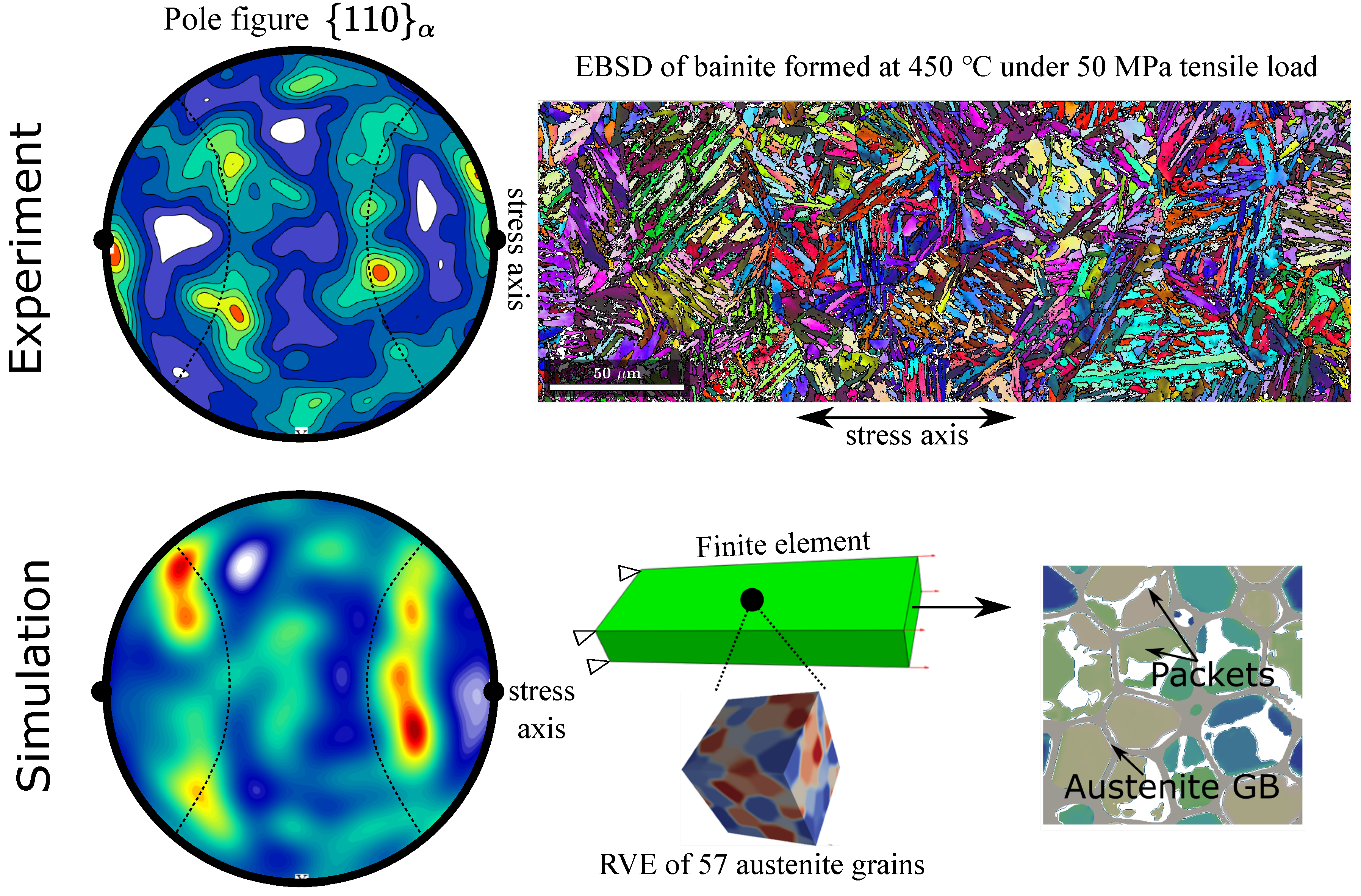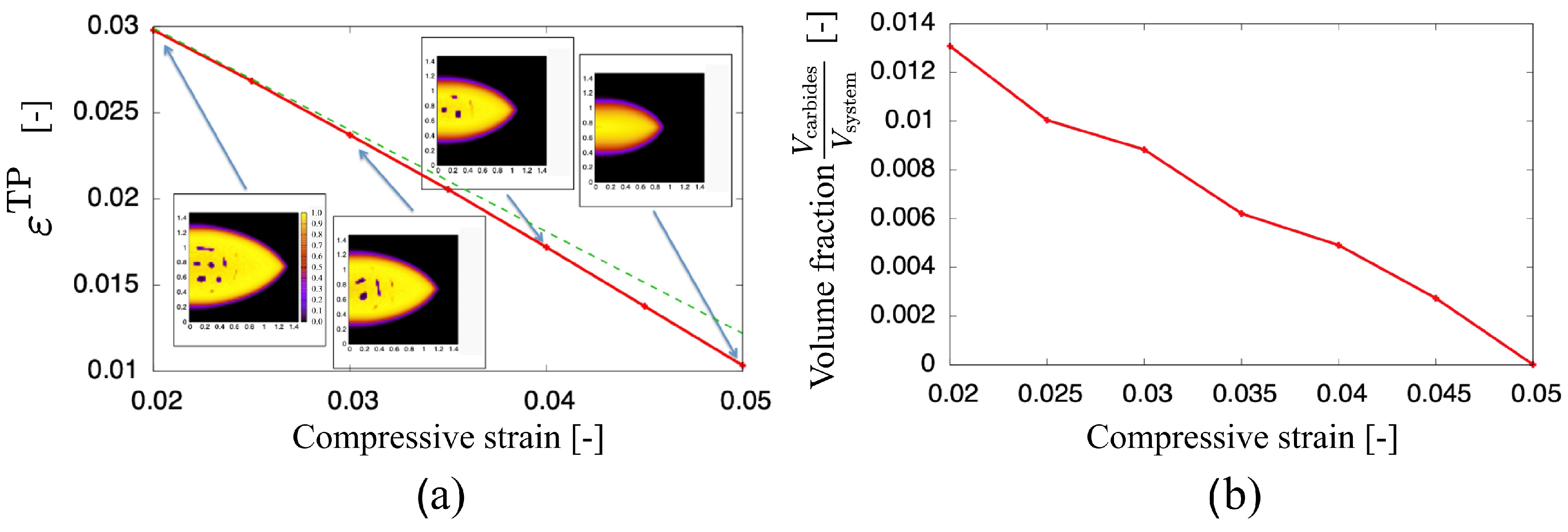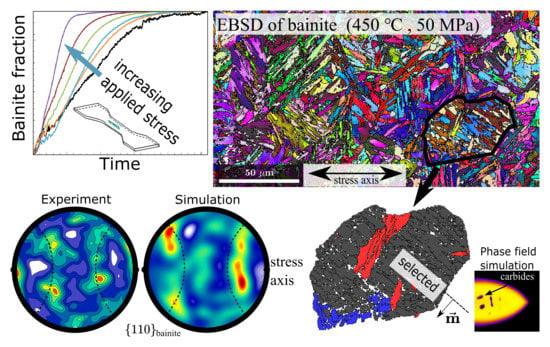Modeling Bainitic Transformations during Press Hardening
Abstract
1. Introduction
2. Results
2.1. Experiments
2.1.1. Experimental Onset
2.1.2. Experimental Results
2.1.3. EBSD Analysis
2.1.4. Multifaceted Correlative Microstructure Characterization
2.2. Modeling and Simulation
2.2.1. Phenomenological Modeling of Bainitic Transformations
2.2.2. Bainite Crystallography and Variant Selection
2.2.3. Full Field Description of Entropy, Free Energy and Dissipation
2.2.4. Non-Diagonal Phase Field Model and Thin Interface Limit
2.2.5. Ab Initio Parameter Generation
2.2.6. Phenomenological Phase Field Description of Bainitic Sheaf Packets
2.2.7. Phase Field Model of Single Bainitic Ferrite Nuclei with Crystal Plasticity Relaxation
2.2.8. Carbide Formation: Thermodynamics
2.2.9. Carbide Formation: Kinetics
2.2.10. Grain Boundary Failure
2.3. Benchmarking and Bainite Toolbox
2.3.1. Benchmarking
2.3.2. Bainitic Micrograph Across the Scales
2.3.3. Precipitate Induced Grain Boundary Deflection
2.3.4. Machine Learning Predictions of the Bainite Start Temperature
3. Discussion
4. Conclusions
Author Contributions
Funding
Data Availability Statement
Acknowledgments
Conflicts of Interest
References
- Min, J.; Lin, J.; Min, Y.; Li, F. On the ferrite and bainite transformation in isothermally deformed 22MnB5 steels. Mater. Sci. Eng. A 2012, 550, 375–387. [Google Scholar] [CrossRef]
- Pathak, N.; Butcher, C.; Worswick, M.J.; Bellhouse, E.; Gao, J. Damage Evolution in Complex-Phase and Dual-Phase Steels during Edge Stretching. Materials 2017, 10, 346. [Google Scholar] [CrossRef] [PubMed]
- Bain, E.C. Persistence of Austenite at Elevated Temperatures. Trans. Am. Soc. Steel Treat. 1925, 8, 14–22. [Google Scholar]
- Bhattacharyya, S.; Kehl, G.L. Isothermal Transformation of Austenite under Externally Applied Tensile Stress; Henry Krumb School of Mines New York: New York, NY, USA, 1954. [Google Scholar]
- Jepson, M.D.; Thompson, F.C. The acceleration of the rate of isothermal transformation of austenite. J. Iron Steel Inst. 1949, 162, 49. [Google Scholar]
- Singh, S.B. Mechanisms of bainite transformation in steels. In Phase Transformations in Steels; Elsevier: Amsterdam, The Netherlands, 2012; pp. 385–416. [Google Scholar] [CrossRef]
- Freiwillig, R.; Kudrman, J.; Chráska, P. Bainite transformation in deformed austenite. Metall. Trans. A 1976, 7, 1091–1097. [Google Scholar] [CrossRef]
- Maier, H.; Ahrens, U. Isothermal bainitic transformation in low alloy steels: Factors limiting prediction of the resulting material’s properties. Z. Met. 2002, 93, 712–718. [Google Scholar] [CrossRef]
- Kundu, S.; Hase, K.; Bhadeshia, H. Crystallographic texture of stress-affected bainite. Proc. R. Soc. Lond. Ser. A 2007, 463, 2309–2328. [Google Scholar] [CrossRef]
- Hase, K.; Garcia-Mateo, C.; Bhadeshia, H. Bainite formation influenced by large stress. Mater. Sci. Technol. 2004, 20, 1499–1505. [Google Scholar] [CrossRef]
- Holzweissig, M.J.; Canadinc, D.; Maier, H.J. In-situ characterization of transformation plasticity during an isothermal austenite-to-bainite phase transformation. Mater. Charact. 2012, 65, 100–108. [Google Scholar] [CrossRef]
- Su, T.J.; Aeby-Gautier, E.; Denis, S. Morphology changes in bainite formed under stress. Scr. Mater. 2006, 54, 2185–2189. [Google Scholar] [CrossRef]
- Su, T.J.; Veaux, M.; Aeby-Gautier, E.; Denis, S.; Brien, V.; Archambault, P. Effect of tensile stresses on bainitic isothermal transformation. J. Phys. IV 2003, 112, 293–296. [Google Scholar] [CrossRef]
- Zolotorevsky, N.; Nesterova, E.; Titovets, Y.; Khlusova, E. Modeling the effect of austenite deformation on the bainite structure parameters in low carbon microalloyed steels. Int. J. Mater. Res. 2013, 104, 337–343. [Google Scholar] [CrossRef]
- Edwards, R.H.; Kennon, N.F. The Morphology and Mechanical Properties of Bainite Formed from Deformed Austenite. Metall. Trans. A 1978, 9, 1801–1809. [Google Scholar] [CrossRef]
- Fischer, F.D.; Reisner, G.; Werner, E.; Tanaka, K.; Cailletaud, G.; Antretter, T. A new view on transformation induced plasticity (TRIP). Int. J. Plast. 2000, 16, 723–748. [Google Scholar] [CrossRef]
- Kubler, R.F.; Berveiller, M.; Buessler, P. Semi phenomenological modelling of the behavior of TRIP steels. Int. J. Plast. 2011, 27, 299–327. [Google Scholar] [CrossRef][Green Version]
- Mahnken, R.; Schneidt, A.; Antretter, T.; Ehlenbröker, U.; Wolff, M. Multi-scale modeling of bainitic phase transformation in multi-variant polycrystalline low alloy steels. Int. J. Solids Struct. 2015, 54, 156–171. [Google Scholar] [CrossRef]
- Cayron, C. EBSD imaging of orientation relationships and variant groupings in different martensitic alloys and Widmanstätten iron meteorites. Mater. Charact. 2014, 94, 93–110. [Google Scholar] [CrossRef]
- Furuhara, T.; Kawata, H.; Morito, S.; Maki, T. Crystallography of upper bainite in Fe–Ni–C alloys. Mater. Sci. Eng. A 2006, 431, 228–236. [Google Scholar] [CrossRef]
- Bernier, N.; Bracke, L.; Malet, L.; Godet, S. Crystallographic Reconstruction Study of the Effects of Finish Rolling Temperature on the Variant Selection During Bainite Transformation in C-Mn High-Strength Steels. Metall. Mater. Trans. A 2014, 45, 5937–5955. [Google Scholar] [CrossRef]
- Fielding, L.C.D. The Bainite Controversy. Mater. Sci. Technol. 2013, 29, 383–399. [Google Scholar] [CrossRef]
- Takahashi, M. Recent progress: Kinetics of the bainite transformation in steels. Curr. Opin. Solid State Mater. Sci. 2004, 8, 213–217. [Google Scholar] [CrossRef]
- Rees, G.I.; Bhadeshia, H.K.D.H. Bainite transformation kinetics Part 1 Modified model. Mater. Sci. Technol. 1992, 8, 985–993. [Google Scholar] [CrossRef]
- Tzeng, T. Autocatalysis in bainite transformations. Mater. Sci. Eng. A 2000, 293, 185–190. [Google Scholar] [CrossRef]
- Gaude-Fugarolas, D.; Jacques, P. A new physical model for the kinetics of the bainite transformation. ISIJ Int. 2006, 46, 712–717. [Google Scholar] [CrossRef]
- Ravi, A.M.; Sietsma, J.; Santofimia, M.J. Exploring bainite formation kinetics distinguishing grain-boundary and autocatalytic nucleation in high and low-Si steels. Acta Mater. 2016, 105, 155–164. [Google Scholar] [CrossRef]
- Van Bohemen, S.M.C.; Hanlon, D.N. A physically based approach to model the incomplete bainitic transformation in high-Si steels. Int. J. Mater. Res. 2012, 103, 987–991. [Google Scholar] [CrossRef]
- Kundu, S.; Bhadeshia, H. Crystallographic texture and intervening transformations. Scr. Mater. 2007, 57, 869–872. [Google Scholar] [CrossRef]
- Mahnken, R.; Schneidt, A.; Tschumak, S.; Maier, H.J. On the simulation of austenite to bainite phase transformation. Comput. Mater. Sci. 2011, 50, 1823–1829. [Google Scholar] [CrossRef]
- Arif, T.; Qin, R. A phase-field model for bainitic transformation. Comput. Mater. Sci. 2013, 77, 230–235. [Google Scholar] [CrossRef]
- Song, W.; Prahl, U.; Bleck, W.; Mukherjee, K. Phase-Field Simulations of Bainitic Phase Transformations in 100CR6; TMS: San Diego, CA, USA, 2011. [Google Scholar]
- Song, W.; Prahl, U.; Bleck, W. Computational simulation and atomic scale investigation of two-step bainitic phase transformation kinetics in high carbon steel 100Cr6. In Proceedings of the Asia Steel International Conference 2012, CSM, (CD-ROM), Beijing, China, 24–26 September 2012. [Google Scholar]
- Hüter, C.; Mingxuan, L.; Hunkel, M.; Schicchi, D.S.; Prahl, U.; Spatschek, R. A multiscale perspective on the kinetics of solid state transformations with application to bainite formation. AIMS Mater. Sci. 2015, 2, 319. [Google Scholar] [CrossRef]
- Ruffini, A.; Le Bouar, Y.; Finel, A. Three-dimensional phase-field model of dislocations for a heterogeneous face-centered cubic crystal. J. Mech. Phys. Solids 2017, 105, 95–115. [Google Scholar] [CrossRef]
- Levitas, V.I.; Levin, V.A.; Zingerman, K.M.; Freiman, E.I. Displacive phase transitions at large strains: Phase-field theory and simulations. Phys. Rev. Lett. 2009, 103, 025702. [Google Scholar] [CrossRef] [PubMed]
- Levitas, V.I.; Javanbakht, M. Phase field approach to interaction of phase transformation and dislocation evolution. Appl. Phys. Lett. 2013, 102, 1904. [Google Scholar] [CrossRef]
- Levitas, V.I.; Javanbakht, M. Interaction between phase transformations and dislocations at the nanoscale. Part 1. General phase field approach. J. Mech. Phys. Solids 2015, 82, 287–319. [Google Scholar] [CrossRef]
- Schicchi, D.S.; Hunkel, M. Transformation plasticity and kinetic during bainite transformation on a 22MnB5 steel grade. Materialwiss. Werkstofftech. 2016, 47, 771–779. [Google Scholar] [CrossRef]
- Schicchi, D.S.; Hunkel, M. Effect of Pre-strain and High Stresses on the Bainitic Transformation of Manganese-boron Steel 22MnB5. Metall. Mater. Trans. A 2018, 49, 2011–2025. [Google Scholar] [CrossRef]
- Bachmann, F.; Hielscher, R.; Schaeben, H. Texture Analysis with MTEX — Free and Open Source Software Toolbox. Solid State Phenom. 2010, 160, 63–68. [Google Scholar] [CrossRef]
- Nyssönen, T.; Peura, P.; Kuokkala, V.T. Crystallography, Morphology, and Martensite Transformation of Prior Austenite in Intercritically Annealed High-Aluminum Steel. Metall. Mater. Trans. A 2018, 49, 6426–6441. [Google Scholar] [CrossRef]
- Schicchi, D.S.; Hunkel, M. Influence of the parent phase on the bainitic transformation under large stress of manganese-boron steel 22MnB5. Mater. Charact. 2019, 151, 457–469. [Google Scholar] [CrossRef]
- Zhang, M.X.; Kelly, P. Accurate orientation relationship between ferrite and austenite in low carbon martensite and granular bainite. Scr. Mater. 2002, 47, 749–755. [Google Scholar] [CrossRef]
- Nolze, G. Characterization of the fcc-bcc orientation relationship by EBSD using pole figures and variants. Z. Met. 2004, 95, 744–755. [Google Scholar] [CrossRef]
- Humbert, M.; Blaineau, P.; Germain, L.; Gey, N. Refinement of orientation relations occurring in phase transformation based on considering only the orientation of the variants. Scr. Mater. 2011, 64, 114–117. [Google Scholar] [CrossRef]
- Humbert, M.; Germain, L.; Gey, N.; Boucard, E. Evaluation of the orientation relations from misorientation between inherited variants Application to ausformed martensite. Acta Mater. 2015, 82, 137–144. [Google Scholar] [CrossRef]
- Chang, Y.; Lin, M.; Hangen, U.; Richter, S.; Haase, C.; Bleck, W. Correlative characterization of microstructural heterogeneities in complex-phase steel. Mater. Des. 2021, submitted. [Google Scholar]
- Lin, M.; Chang, Y.; Prahl, U.; Bleck, W. Image registration between EBSD and XPM nano hardness maps using computer vision. In Proceedings of the Nanobrücken—Nanomechanical Testing Conference, Düsseldorf, Germany, 4–6 February 2020. [Google Scholar]
- Schicchi, D.S.; Hunkel, M. A combined finite element—phase field model approach on the bainitic transformation. In Proceedings of the European Conference on Heat Treatment and 3rd International Conference Heat Treatment and Surface Engineering in Automotive Applications, Prague, Czech Republic, 11–13 May 2016. [Google Scholar]
- Van Bohemen, S.M.C.; Sietsma, J. Modeling of isothermal bainite formation based on the nucleation kinetics. Int. J. Mater. Res. 2008, 99, 739–747. [Google Scholar] [CrossRef]
- Rees, G.; Shipway, P. Modelling transformation plasticity during the growth of bainite under stress. Mater. Sci. Eng. A 1997, 223, 168–178. [Google Scholar] [CrossRef]
- Schicchi, D.S.; Caggiano, A.; Hunkel, M.; Koenders, E.A. Thermodynamically consistent multiscale formulation of a thermo-mechanical problem with phase transformations. Contin. Mech. Thermodyn. 2019, 31, 273–299. [Google Scholar] [CrossRef]
- Cayron, C. Shifting the Shear Paradigm in the Crystallographic Models of Displacive Transformations in Metals and Alloys. Crystals 2018, 8, 181. [Google Scholar] [CrossRef]
- Baur, A.P.; Cayron, C.; Logé, R.E. 225 habit planes in martensitic steels: From the PTMC to a continuous model. Sci. Rep. 2017, 7, 40938. [Google Scholar] [CrossRef]
- Cayron, C. Continuous atomic displacements and lattice distortion during fcc–bcc martensitic transformation. Acta Mater. 2015, 96, 189–202. [Google Scholar] [CrossRef]
- Bain, E.C.; Dunkirk, N.Y. The Nature of Martensite. Trans. AIME 1924, 70, 25–47. [Google Scholar]
- Bowles, J.; Mackenzie, J. The crystallography of martensite transformations III. Face-centred cubic to body-centred tetragonal transformations. Acta Metall. 1954, 2, 224–234. [Google Scholar] [CrossRef]
- Mackenzie, J.; Bowles, J. The crystallography of martensite transformations II. Acta Metall. 1954, 2, 138–147. [Google Scholar] [CrossRef]
- Bowles, J.; Mackenzie, J. The crystallography of martensite transformations I. Acta Metall. 1954, 2, 129–137. [Google Scholar] [CrossRef]
- Wayman, C.M. The phenomenological theory of martensite crystallography: Interrelationships. Metall. Mater. Trans. A 1994, 25, 1787–1795. [Google Scholar] [CrossRef]
- Kelly, P.M. Crystallography of martensite transformations in steels. In Phase Transformations in Steel; Pereloma, E., Edmonds, D.V., Eds.; Woodhead: Cambridge, UK, 2012; pp. 3–33. [Google Scholar] [CrossRef]
- Kelly, P.M. Crystallography of Lath Martensite in Steels. Mater. Trans. JIM 1992, 33, 235–242. [Google Scholar] [CrossRef]
- Ravi, A.M.; Sietsma, J.; Santofimia, M.J. Bainite formation kinetics in steels and the dynamic nature of the autocatalytic nucleation process. Scr. Mater. 2017, 140, 82–86. [Google Scholar] [CrossRef]
- Levitas, V.I. Thermodynamically consistent phase field approach to phase transformations with interface stresses. Acta Mater. 2013, 61, 4305–4319. [Google Scholar] [CrossRef]
- Levitas, V.I. Phase-field theory for martensitic phase transformations at large strains. Int. J. Plast. 2013, 49, 85–118. [Google Scholar] [CrossRef]
- Gurtin, M.E. Generalized Ginzburg-Landau and Cahn-Hilliard equations based on a microforce balance. Phys. D 1996, 92, 178–192. [Google Scholar] [CrossRef]
- Miehe, C.; Mauthe, S.; Ulmer, H. Formulation and numerical exploitation of mixed variational principles for coupled problems of Cahn-Hilliard-type and standard diffusion in elastic solids. Int. J. Numer. Methods Eng. 2014, 99, 737–762. [Google Scholar] [CrossRef]
- Miehe, C. A multi-field incremental variational framework for gradient-extended standard dissipative solids. J. Mech. Phys. Solids 2011, 59, 898–923. [Google Scholar] [CrossRef]
- Karma, A.; Rappel, W.J. Quantitative phase-field modeling of dendritic growth in two and three dimensions. Phys. Rev. E 1998, 57, 4323–4349. [Google Scholar] [CrossRef]
- Boussinot, G.; Brener, E.A.; Hüter, C.; Spatschek, R. Elimination of surface diffusion in the non-diagonal phase field model. Contin. Mech. Thermodyn. 2017, 29, 969–976. [Google Scholar] [CrossRef][Green Version]
- Hüter, C.; Friak, M.; Weikamp, M.; Neugebauer, J.; Goldenfeld, N.; Svendsen, B.; Spatschek, R. Nonlinear elastic effects in phase field crystal and amplitude equations: Comparison to ab initio simulations of bcc metals and graphene Nonlinear elastic effects in phase field crystal and amplitude equations: Comparison to ab initio simulations of bcc metals and graphene. Phys. Rev. B 2016, 93, 214105. [Google Scholar]
- Spatschek, R.; Karma, A. Amplitude equations for polycrystalline materials with interaction between composition and stress. Phys. Rev. B 2010, 81, 214201. [Google Scholar] [CrossRef]
- Prahl, U.; Lin, M.; Weikamp, M.; Hueter, C.; Schicchi, D.; Hunkel, M.; Spatschek, R. Multiscale, Coupled Chemo-mechanical Modeling of Bainitic Transformation During Press Hardening. In Proceedings of the 4th World Congress on Integrated Computational Materials Engineering (ICME), Ypsilanti, MI, USA, 21–25 May 2017; Mason, P., Fisher, C.R., Glamm, R., Manuel, M.V., Schmitz, G.J., Singh, A.K., Strachan, A., Eds.; Springer International Publishing: Cham, Switzerland, 2017; pp. 335–343. [Google Scholar] [CrossRef]
- Lin, M.; Prahl, U. A parallelized model for coupled phase field and crystal plasticity simulation. Comput. Methods Mater. Sci. 2016, 16, 156–162. [Google Scholar]
- Lin, M.; Schicchi, D.S.; Hunkel, M.; Prahl, U. Bainitic Transformation for Press Hardening Applications: A Multiscale FE-MPF Coupled Approach. Available online: https://2018.mse-congress.de/index.php?id=5980&tx_dgmprogram_fullprogram%5Bsession%5D=4438&tx_dgmprogram_fullprogram%5Baction%5D=show&tx_dgmprogram_fullprogram%5Bcontroller%5D=Session&cHash=d75cf2e85d340f9a15d78f22ee826858 (accessed on 20 January 2021).
- Steinbach, I.; Pezzolla, F. A generalized field method for multiphase transformations using interface fields. Phys. D 1999, 134, 385–393. [Google Scholar] [CrossRef]
- Roters, F.; Diehl, M.; Shanthraj, P.; Eisenlohr, P.; Reuber, C.; Wong, S.L.; Maiti, T.; Ebrahimi, A.; Hochrainer, T.; Fabritius, H.O.; et al. DAMASK—The Düsseldorf Advanced Material Simulation Kit for modeling multi-physics crystal plasticity, thermal, and damage phenomena from the single crystal up to the component scale. Comput. Mater. Sci. 2019, 158, 420–478. [Google Scholar] [CrossRef]
- Ta, N.; Wang, K.; Yin, X.; Fleck, M.; Hüter, C. Elastically induced pattern formation in the initial and frustrated growth regime of bainitic subunits. AIMS Mater. Sci. 2019, 6, 52. [Google Scholar]
- Spatschek, R.; Gobbi, G.; Hüter, C.; Chakrabarty, A.; Aydin, U.; Brinckmann, S.; Neugebauer, J. Scale bridging description of coherent phase equilibria in the presence of surfaces and interfaces. Phys. Rev. B 2016, 94, 134106. [Google Scholar] [CrossRef]
- Weikamp, M.; Spatschek, R. Effect of shear-coupled grain boundary motion on coherent precipitation. Phys. Rev. B 2019, 100. [Google Scholar] [CrossRef]
- Cahn, J.W. Coherent fluctuations and nucleation in isotropic solids. Acta Metall. 1962, 10, 907. [Google Scholar] [CrossRef]
- Cahn, J.; Larché, F. A simple model for coherent equilibrium. Acta Metall. 1984, 32, 1915. [Google Scholar] [CrossRef]
- Karma, A.; Trautt, Z.T.; Mishin, Y. Relationship between Equilibrium Fluctuations and Shear-Coupled Motion of Grain Boundaries. Phys. Rev. Lett. 2012, 109, 095501. [Google Scholar] [CrossRef]
- Weikamp, M.; Hüter, C.; Spatschek, R. Linking Ab Initio Data on Hydrogen and Carbon in Steel to Statistical and Continuum Descriptions. Metals 2018, 8, 219. [Google Scholar] [CrossRef]
- Wang, K.; Weikamp, M.; Lin, M.; Zimmermann, C.; Schwaiger, R.; Prahl, U.; Hunkel, M.; Spatschek, R. Influence of Interface Proximity on Precipitation Thermodynamics. Metals 2020, 10, 1292. [Google Scholar] [CrossRef]
- Düsing, M.; Mahnken, R. Simulation of lower bainitic transformation with the phase-field method considering carbide formation. Comput. Mater. Sci 2016, 111, 91–100. [Google Scholar] [CrossRef]
- Steinbach, I.; Pezzolla, F.; Nestler, B.; Seeßelberg, M.; Prieler, R.; Schmitz, G.J.; Rezende, J.L. A phase field concept for multiphase systems. Phys. D 1996, 94, 135–147. [Google Scholar] [CrossRef]
- Golling, S.; Östlund, R.; Oldenburg, M. Characterization of ductile fracture properties of quench-hardenable boron steel: Influence of microstructure and processing conditions. Mater. Sci. Eng. A 2016, 658, 472–483. [Google Scholar] [CrossRef]
- Quidort, D.; Brechet, Y. Isothermal growth kinetics of bainite in 0.5% C steels. Acta Mater. 2001, 49, 4161–4170. [Google Scholar] [CrossRef]
- Weikamp, M.; Hüter, C.; Lin, M.; Prahl, U.; Schicchi, D.; Hunkel, M.; Spatschek, R. Scale Bridging Simulations of Large Elastic Deformations and Bainitic Transformations. In High-Performance Scientific Computing; Lecture Notes in Computer Science; Di Napoli, E., Hermanns, M.A., Iliev, H., Lintermann, A., Peyser, A., Eds.; Springer International Publishing: Cham, Switzerland, 2017; Volume 10164, pp. 125–138. [Google Scholar] [CrossRef]
- Bhogireddy, V.S.P.K.; Hüter, C.; Neugebauer, J.; Shchyglo, O.; Steinbach, I.; Spatschek, R. From wetting to melting along grain boundaries using phase field and sharp interface methods. Comput. Mater. Sci. 2015, 108, 293–300. [Google Scholar] [CrossRef]
- Li, X.; Bottler, F.; Spatschek, R.; Schmitt, A.; Heilmaier, M.; Stein, F. Coarsening kinetics of lamellar microstructures: Experiments and simulations on a fully-lamellar Fe-Al in situ composite. Acta Mater. 2017, 127, 230–243. [Google Scholar] [CrossRef]
- Cline, H. Shape instabilities of eutectic composites at elevated temperatures. Acta Metall. 1971, 19, 10. [Google Scholar] [CrossRef]
- Graham, L.; Kraft, R. Coarsening of eutectic microstructures at elevated temperatures. Trans. Metall. Soc. AIME 1966, 94, 9. [Google Scholar]
- OpenPhase Software GmbH. Available online: https://openphase-solutions.com/ (accessed on 1 December 2020).
- Darvishi Kamachali, R.; Schwarze, C.; Lin, M.; Diehl, M.; Shanthraj, P.; Prahl, U.; Steinbach, I.; Raabe, D. Numerical Benchmark of Phase-Field Simulations with Elastic Strains: Precipitation in the Presence of Chemo-Mechanical Coupling. Comput. Mater. Sci. 2018, 155, 541–553. [Google Scholar] [CrossRef]
- Wang, K.; Boussinot, G.; Hüter, C.; Brener, E.A.; Spatschek, R. Modeling of dendritic growth using a quantitative nondiagonal phase field model. Phys. Rev. Mater. 2020, 4, 033802. [Google Scholar] [CrossRef]
- Lin, M. Interactive Map for Bainitic Microstructure of 22MnB5. Available online: https://gdlmx.github.io/22MnB5/example.html (accessed on 1 December 2020).
- Hehemann, R.F.; Kinsman, K.R.; Aaronson, H.I. A debate on the bainite reaction. Metall. Trans. 1972, 3, 1077–1094. [Google Scholar] [CrossRef]
- Hillert, M. The Nature of Bainite. ISIJ Int. 1995, 35, 1134–1140. [Google Scholar] [CrossRef]
- Santofimia, M.J.; Caballero, F.G.; Capdevila, C.; García-Mateo, C.; de Andrés, C.G. New model for the overall transformation kinetics of bainite. Part 1: The model. Mater. Trans. 2006, 47, 2465–2472. [Google Scholar] [CrossRef]
- Santofimia, M.J.; Caballero, F.G.; Capdevila, C.; García-Mateo, C.; de Andrés, C.G. New model for the overall transformation kinetics of bainite. Part 2: Validation. Mater. Trans. 2006, 47, 2473–2479. [Google Scholar] [CrossRef][Green Version]
- Haynes, A.; Steven, W. The temperature of formation of martensite and bainite in low-alloy steel. J. Iron Steel Inst. 1956, 183, 349–359. [Google Scholar]
- Kunitake, T.; Okada, Y. The estimation of bainite transformation temperatures in steels by the empirical formulas. Tetsu-to-Hagane 1998, 84, 137–141. [Google Scholar] [CrossRef]
- Lee, Y. Empirical formula of isothermal bainite start temperature of steels. J. Mater. Sci. Lett. 2002, 21, 1253–1255. [Google Scholar] [CrossRef]
- Saunders, N.; Miodownik, A.P. CALPHAD (Calculation of Phase Diagrams): A Comprehensive Guide; Elsevier: Amsterdam, The Netherlands, 1998. [Google Scholar]
- Olson, G.B.; Cohen, M. A general mechanism of martensitic nucleation: Part II. FCC → BCC and other martensitic transformations. Metall. Trans. A 1976, 7, 1905–1914. [Google Scholar]
- Bhadeshia, H. Bainite in Steels–Transformation, Microstructure and Properties; The Institute of Materials, University of Cambridge: Cambridge, UK, 2001. [Google Scholar]
- Hüter, C.; Yin, X.; Vo, T.; Braun, S. A pragmatic dataset augmentation approach for transformation temperature prediction in steels. Comput. Mater. Sci. 2020, 176, 109488. [Google Scholar] [CrossRef]
- Koumatos, K.; Muehlemann, A. A theoretical investigation of orientation relationships and transformation strains in steels. Acta Crystallogr. Sect. A Found. Crystallogr. 2017, 73, 115–123. [Google Scholar] [CrossRef]
- Jülich Supercomputing Centre. JURECA: Modular supercomputer at Jülich Supercomputing Centre. J.-Large-Scale Res. Facil. 2018, 4, 132. [Google Scholar] [CrossRef]















Publisher’s Note: MDPI stays neutral with regard to jurisdictional claims in published maps and institutional affiliations. |
© 2021 by the authors. Licensee MDPI, Basel, Switzerland. This article is an open access article distributed under the terms and conditions of the Creative Commons Attribution (CC BY) license (http://creativecommons.org/licenses/by/4.0/).
Share and Cite
Lin, M.; Zimmermann, C.; Wang, K.; Hunkel, M.; Prahl, U.; Spatschek, R. Modeling Bainitic Transformations during Press Hardening. Materials 2021, 14, 654. https://doi.org/10.3390/ma14030654
Lin M, Zimmermann C, Wang K, Hunkel M, Prahl U, Spatschek R. Modeling Bainitic Transformations during Press Hardening. Materials. 2021; 14(3):654. https://doi.org/10.3390/ma14030654
Chicago/Turabian StyleLin, Mingxuan, Carina Zimmermann, Kai Wang, Martin Hunkel, Ulrich Prahl, and Robert Spatschek. 2021. "Modeling Bainitic Transformations during Press Hardening" Materials 14, no. 3: 654. https://doi.org/10.3390/ma14030654
APA StyleLin, M., Zimmermann, C., Wang, K., Hunkel, M., Prahl, U., & Spatschek, R. (2021). Modeling Bainitic Transformations during Press Hardening. Materials, 14(3), 654. https://doi.org/10.3390/ma14030654







